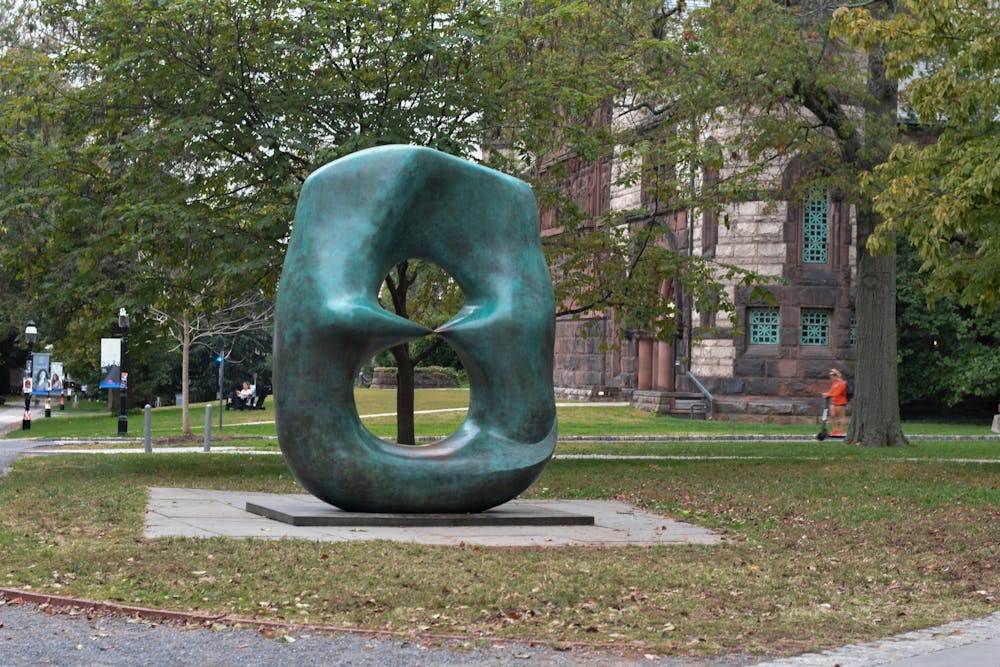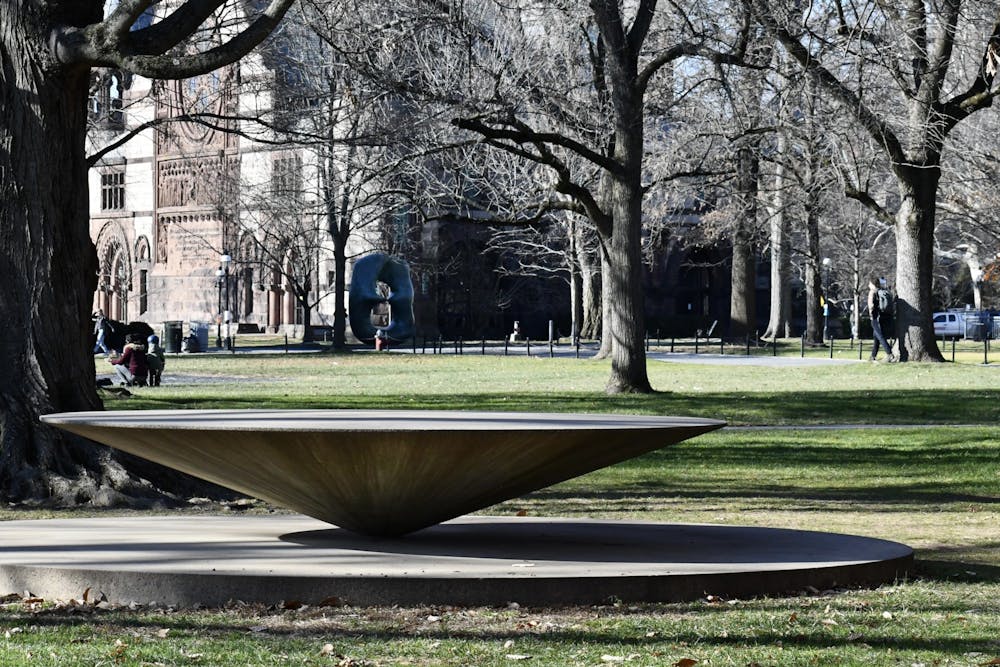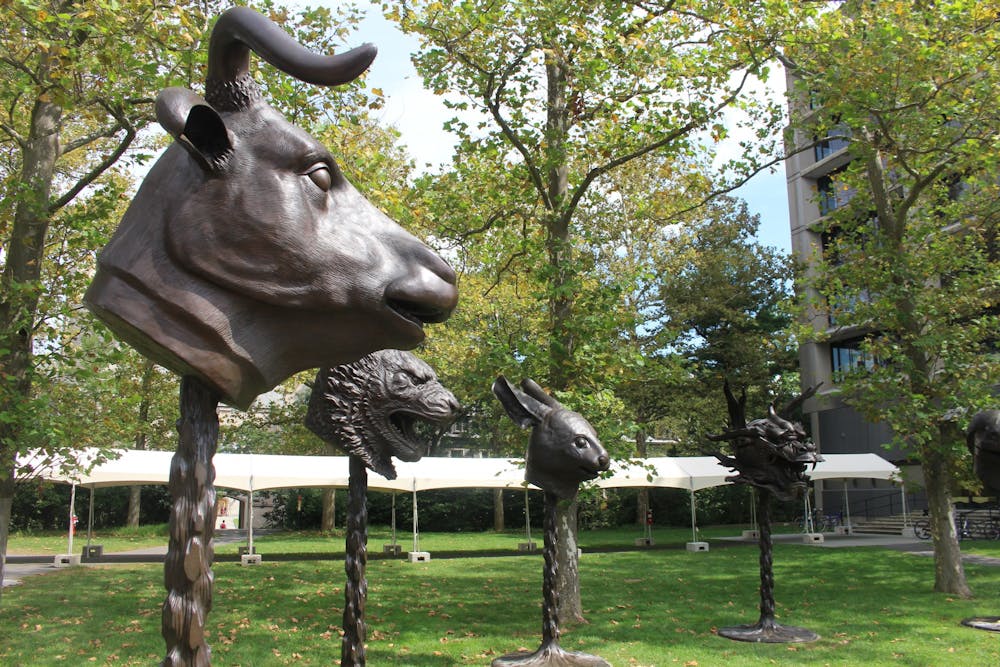Before explaining the history of Louise Nevelson’s “Atmosphere and Environment X,” molecular biology graduate student Robbie LeDesma began his tour of the University’s campus art with a question: “What do you notice?”
The tour group walked around to examine the 50-year-old sculpture, characterized by its weathering geometric steel panels. One participant noted that its dimensions are only apparent by viewing the work from different angles, and LeDesma noted the tendency of the shiny steel, over time, to rust in response to the elements.

“Atmosphere and Environment X” by Louise Nevelson.
Natalia Maidique / The Daily Princetonian
The Princeton University Art Museum (PUAM) held a series of outdoor campus art tours this fall, allowing the community to engage even as its main building is closed for renovation until 2024. Student guides shared sculpture history and formal analysis on separate tours of two neighborhoods: The main campus, which includes Henry Moore’s “Oval with Points” and Jacques Lipchitz’s “Song of the Vowels,” and the residential colleges, which includes Ai WeiWei’s “Circle of Animals/Zodiac Heads” and Maya Lin’s “Einstein’s Table.”
According to Cara Bramson, student outreach and programming coordinator at PUAM, the tours allow participants to more fully appreciate Princeton’s campus.
“The sculptures become a part of your everyday life because you walk by them all the time,” Bramson said, “but you don't really know their background or how they were made.”
PUAM’s campus art collection contains over 70 pieces, with many of the oldest representing prominent figures in the University’s history. In 1968, the John B. Putnam Jr. Memorial Collection launched the addition of over 20 modern sculptures. According to Modern and Contemporary Art Curator Mitra Abbaspour, PUAM is looking to diversify campus art with respect to both material — many original pieces are of stone or metal — and the backgrounds of the sculptors themselves.
“Sculptures build a sense of identity within a place,” Abbaspour said. “They interrupt your passage of space and change the way you see the world around you. And often that happens even without you realizing it.”


“Song of the Vowels” by Jacques Lipchitz.
Natalia Maidique / The Daily Princetonian
PUAM’s campus art collection attracts individuals with wide-ranging affiliations to the University to attend tours, with participants ranging from molecular biology department staff to family members of economics professors.
Elsie Sheidler, senior associate director for the Pace Center for Civic Engagement, attended a main campus neighborhood tour with her colleagues.
“I've been here for such a long time and never appreciated the art as I should,” Sheidler said. “I was happy to have the art elevated, and I was reminded that I should pay more attention to it.”

Just as tour participants come from all corners of the University, student guides also have a range of academic backgrounds beyond art history.
Outside of his research in virology, LeDesma has enjoyed spending time at PUAM galleries since beginning at the University.
“I'm kind of a nerd. I really like learning about history, and I really like learning about art,” LeDesma said. Engaging with PUAM’s collections, he continued, “[is] a unique way to interact with the world and to process things.”
For prospective politics concentrator Josh Rogers ’24, being a tour guide allows him to pursue an interest that doesn’t fit in his class schedule.
“Expanding into a different field, like modern art, makes you think about things that you normally wouldn’t,” Rogers said.

“Oval with Points” by Henry Moore.
Angel Kuo / The Daily Princetonian
“Now, whenever I look at ‘Oval with Points,’ I see an elephant skull,” he added, referencing Moore’s inspiration for the 1969 sculpture, an East Asian elephant skull discovered by biologist Sir Julian Huxley.
According to Abbaspour, many of the outdoor sculptures are “remarkable” for being the first piece by a prominent artist in a specific medium. In addition to their artistic significance, though, the sculptures are meant to be interacted with by the community.
Bramson pointed to Scott Burton’s concrete “Public Table” as an example.
“Students can eat on it, they can stand on it,” she said. “One day I saw a group of students have a one-minute group hug [on the sculpture] as a performance art piece. It was very heartwarming.”

“Public Table” by Scott Burton.
Natalia Maidique / The Daily Princetonian
After her tour, Sheidler expressed similar sentiments about the interactive aspect of “Public Table.”
“The fact that it is to be used amuses me, because I always think, ‘that's a piece of art, should you really be sitting on it and touching it?’” Sheidler said. “But art at Princeton was certainly made for public consumption, for bringing the community together.”
Molly Taylor is a first-year Features contributor. She can be reached at mollypt@princeton.edu.








